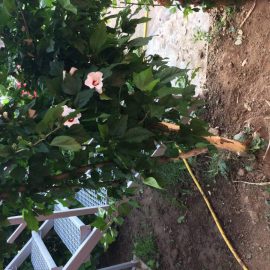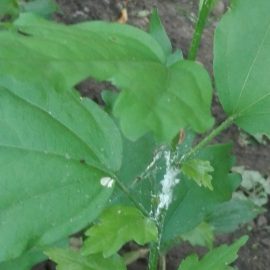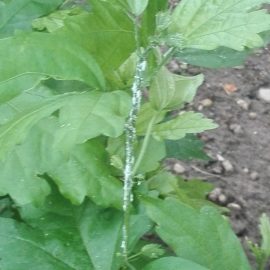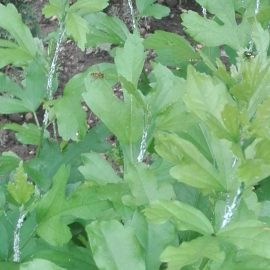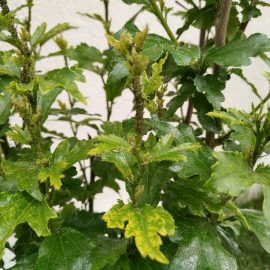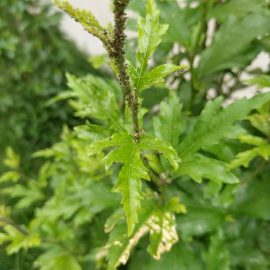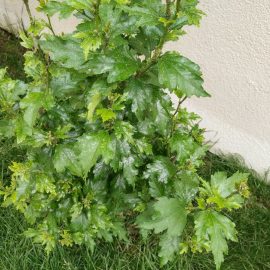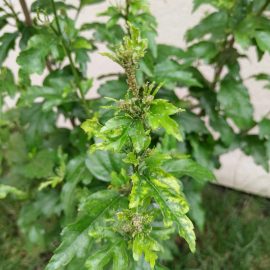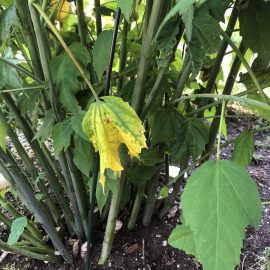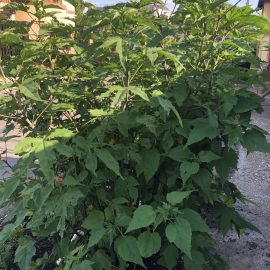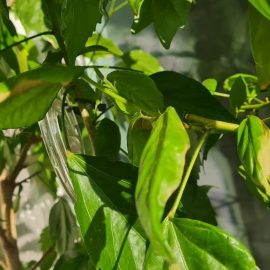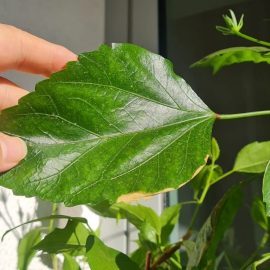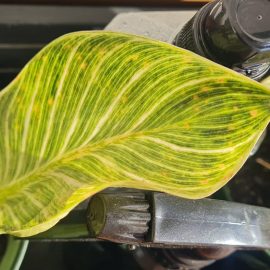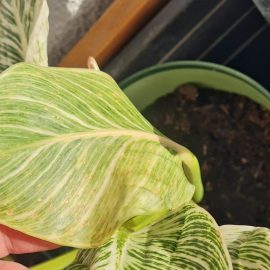Hibiscus syriacus, planting guide and care work

Hibiscus syriacus is a flowering plant in the form of a shrub, native to China and Anatolia. The name of the species comes from the fact that it can often be found in the gardens of Syria. It is suitable for growing outdoors, both in warm and mountainous areas. It can grow up to 2-4 m in height, has lobed, dark green leaves, and blooms in summer-autumn. The flowers are trumpet-shaped, are variously colored (pink, purple, white), have a red-scarlet spot in the center and white-yellow stamens.
Cultivars
Numerous cultivars were obtained from the Hibiscus syriacus species, different in the color and shape of the flowers.
- “Hamambo”, with simple, large, pink flowers, with a carmine-red center;
- “Red Heart”, with simple white flowers with a red center;
- “Oiseau Bleu”, with simple flowers, blue-lilac in color and purple in the center;
- “Duc de Brabant”, with double flowers, colored in dark red;
- “Roseus Plenus”, with double, pink-purple flowers.




Environmental conditions
Light. It is a plant that prefers light and can be placed in direct sunlight, but it can also grow in partially shaded places.
Temperature. It has no special temperature requirements and it is resistant to frost if temperatures do not drop below -25° C.
Soil. It has no special requirements regarding the soil, it can withstand calcareous, sandy, or clay soils.
Fertilization
During the vegetative growth period, a specific fertilizer can be administered.
Recommended products
-
You can find products on a different store
Change Store -
You can find products on a different store
Change Store -
You can find products on a different store
Change Store -
You can find products on a different store
Change Store -
You can find products on a different store
Change Store -
You can find products on a different store
Change Store -
You can find products on a different store
Change Store -
You can find products on a different store
Change Store -
You can find products on a different store
Change Store -
You can find products on a different store
Change Store -
You can find products on a different store
Change Store -
You can find products on a different store
Change Store -
You can find products on a different store
Change Store -
You can find products on a different store
Change Store -
You can find products on a different store
Change Store -
You can find products on a different store
Change Store -
You can find products on a different store
Change Store -
You can find products on a different store
Change Store -
You can find products on a different store
Change Store -
You can find products on a different store
Change Store -
You can find products on a different store
Change Store -
You can find products on a different store
Change Store -
You can find products on a different store
Change Store -
You can find products on a different store
Change Store
Pruning
Annually, in early spring, the shape correction cuts can be done to maintain the appearance, because the shrub shoots strongly. Short cuts favor abundant flowering.
Recommended products
-
You can find products on a different store
Change Store -
You can find products on a different store
Change Store -
You can find products on a different store
Change Store -
You can find products on a different store
Change Store -
You can find products on a different store
Change Store -
You can find products on a different store
Change Store -
You can find products on a different store
Change Store -
You can find products on a different store
Change Store -
You can find products on a different store
Change Store -
You can find products on a different store
Change Store -
You can find products on a different store
Change Store -
You can find products on a different store
Change Store -
You can find products on a different store
Change Store -
You can find products on a different store
Change Store -
You can find products on a different store
Change Store -
You can find products on a different store
Change Store -
You can find products on a different store
Change Store -
You can find products on a different store
Change Store -
You can find products on a different store
Change Store -
You can find products on a different store
Change Store -
You can find products on a different store
Change Store -
You can find products on a different store
Change Store -
You can find products on a different store
Change Store -
You can find products on a different store
Change Store
Planting
Usually, this shrub is purchased in pots, and the optimal time for planting is in autumn or spring, in a sunny place, away from strong winds.
Propagation
Hibiscus syriacus can be easily propagated through seeds, which should be sown in spring (April). Propagation can also be done through cleft grafting, cuttings, or layering, but these procedures are recommended for professionals.
Recommended products
-
You can find products on a different store
Change Store -
You can find products on a different store
Change Store -
You can find products on a different store
Change Store -
You can find products on a different store
Change Store -
You can find products on a different store
Change Store -
You can find products on a different store
Change Store -
You can find products on a different store
Change Store -
You can find products on a different store
Change Store -
You can find products on a different store
Change Store -
You can find products on a different store
Change Store -
You can find products on a different store
Change Store -
You can find products on a different store
Change Store -
You can find products on a different store
Change Store -
You can find products on a different store
Change Store -
You can find products on a different store
Change Store -
You can find products on a different store
Change Store -
You can find products on a different store
Change Store -
You can find products on a different store
Change Store -
You can find products on a different store
Change Store -
You can find products on a different store
Change Store -
You can find products on a different store
Change Store -
You can find products on a different store
Change Store -
You can find products on a different store
Change Store -
You can find products on a different store
Change Store
Pests
Aphids can infest the plant most often.
Recommended products
-
You can find products on a different store
Change Store -
You can find products on a different store
Change Store -
You can find products on a different store
Change Store -
You can find products on a different store
Change Store -
You can find products on a different store
Change Store -
You can find products on a different store
Change Store -
You can find products on a different store
Change Store -
You can find products on a different store
Change Store -
You can find products on a different store
Change Store -
You can find products on a different store
Change Store -
You can find products on a different store
Change Store -
You can find products on a different store
Change Store -
You can find products on a different store
Change Store -
You can find products on a different store
Change Store -
You can find products on a different store
Change Store -
You can find products on a different store
Change Store -
You can find products on a different store
Change Store -
You can find products on a different store
Change Store -
You can find products on a different store
Change Store -
You can find products on a different store
Change Store -
You can find products on a different store
Change Store -
You can find products on a different store
Change Store -
You can find products on a different store
Change Store -
You can find products on a different store
Change Store
In addition:
- regular cuts of the branches favor the penetration of light towards the inner part of the shrub.
- it is a shrub commonly used in the form of a hedge.
- plants obtained from seeds do not keep the characteristics of the mother plant.
- it is a plant resistant to droughts.














































































































































































































































































































































































































































